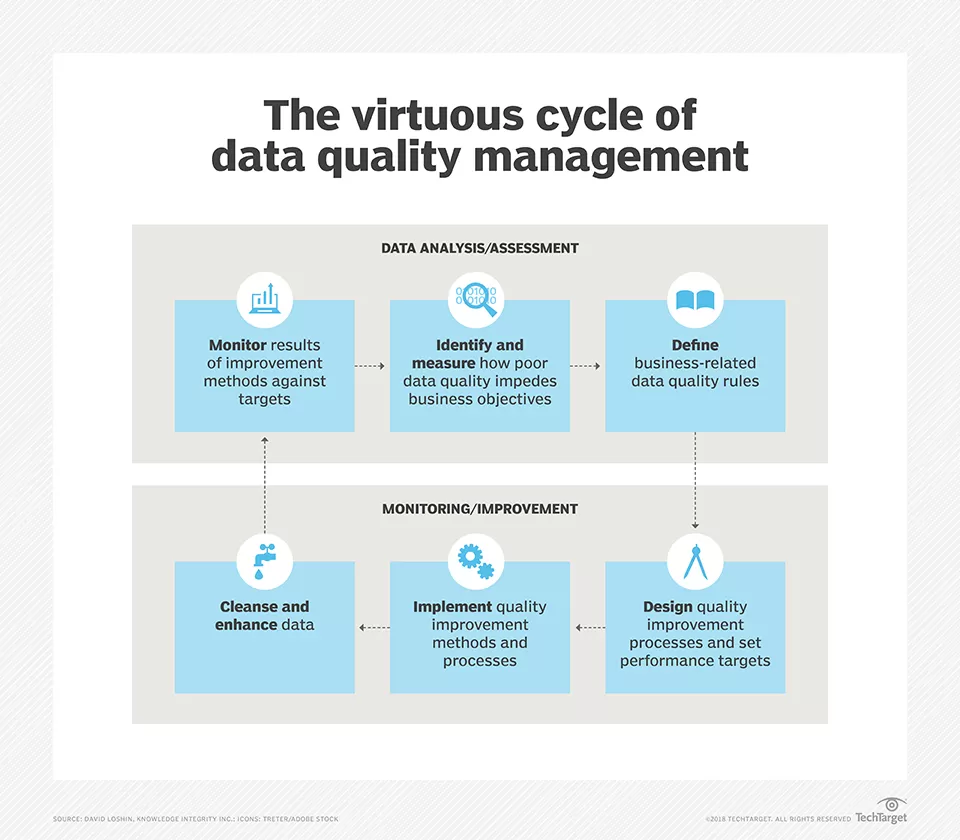Data quality is essential for ecommerce. It is defined as the measure of the condition of data based on factors such as accuracy, completeness, consistency, reliability and whether it’s up to date. Measuring data quality levels can help organisations identify data errors that need to be resolved and assess whether the data in their IT systems is fit to serve its intended purpose.
The emphasis on data quality in enterprise systems has increased as data processing has become more intricately linked with business operations and organisations increasingly use data analytics to help drive business decisions.
Data quality management is a core component of the overall data management process, and data quality improvement efforts are often closely tied to data governance programs that aim to ensure data is formatted and used consistently throughout an organisation.
Why data quality is important
Bad data can have significant business consequences for companies. Poor-quality data is often pegged as the source of operational chaos, inaccurate analytics and ill-conceived business strategies. Examples of the economic damage that data quality problems can cause include added expenses when products are shipped to the wrong customer addresses, lost sales opportunities because of erroneous or incomplete customer records, and fines for improper financial or regulatory compliance reporting.
An oft-cited estimate by IBM calculated that the annual cost of data quality issues in the U.S. amounted to $3.1 trillion. Now relate that sum to your company, how much are you losing? In an article he wrote for the MIT Sloan Management Review in 2017, data quality consultant Thomas Redman estimated that correcting data errors and dealing with the business problems caused by bad data costs companies 15% to 25% of their annual revenue on average.
In addition, a lack of trust in data on the part of corporate executives and business managers is commonly cited among the chief impediments to using business intelligence (BI) and analytics tools to improve decision-making in organisations.

What is good data quality?
Data accuracy is a key attribute of high-quality data. To avoid transaction processing problems in operational systems and faulty results in analytics applications, the data that’s used must be correct. Inaccurate data needs to be identified, documented and fixed to ensure that executives, data analysts and other end users are working with good information.
Other aspects, or dimensions, that are important elements of good data quality include data completeness, with data sets containing all of the data elements they should:
i. Data consistency, where there are no conflicts between the same data values in different systems or data sets.
ii. A lack of duplicate data records in databases; data currency, meaning that data has been updated as needed to keep it current.
iii. Conformity to the standard data formats created by an organisation. Meeting all of these factors helps produce data sets that are reliable and trustworthy.
How to determine data quality
As a first step toward determining their data quality levels, organisations typically perform data asset inventories in which the relative accuracy, uniqueness and validity of data are measured in baseline studies.
The established baseline ratings for data sets can then be compared against the data in systems on an ongoing basis to help identify new data quality issues so they can be resolved.
Another common step is to create a set of data quality rules based on business requirements for both operational and analytics data. Such rules specify required quality levels in data sets and detail what different data elements need to include so they can be checked for accuracy, consistency and other data quality attributes.
After the rules are in place, a data management team typically conducts a data quality assessment to measure the quality of data sets and document data errors and other problems — a procedure that can be repeated at regular intervals to maintain the highest data quality levels possible.
Various methodologies for such assessments have been developed. For example, data managers at UnitedHealth Group‘s Optum Healthcare Services subsidiary created the Data Quality Assessment Framework (DQAF) to formalise a method for assessing its data quality.
The DQAF provides guidelines for measuring data quality dimensions that include completeness, timeliness, validity, consistency and integrity. Optum has publicised details about the framework as a possible model for other organisations.
The International Monetary Fund (IMF), which oversees the global monetary system and lends money to economically troubled nations, has also specified an assessment methodology, similarly known as the Data Quality Assessment Framework.
Its framework focuses on accuracy, reliability, consistency and other data quality attributes in the statistical data that member countries need to submit to the IMF.
Data quality management tools and techniques
Data quality projects typically also involve several other steps. For example, a data quality management cycle outlined by data management consultant David Loshin begins with identifying and measuring the effect that bad data has on business operations.
Next, data quality rules are defined, performance targets for improving relevant data quality metrics are set, and specific data quality improvement processes are designed and put in place.
Those processes include data cleansing, or data scrubbing, to fix data errors, plus work to enhance data sets by adding missing values, more up-to-date information or additional records. The results are then monitored and measured against the performance targets, and any remaining deficiencies in data quality provide a starting point for the next round of planned improvements.
Such a cycle is intended to ensure that efforts to improve overall data quality continue after individual projects are completed.
Software tools specialised for data quality management can match records, delete duplicates, validate new data, establish remediation policies and identify personal data in data sets; they also do data profiling to collect information about data sets and identify possible outlier values.
Management consoles for data quality initiatives support creation of data handling rules, discovery of data relationships and automated data transformations that may be part of data quality maintenance efforts.
Collaboration and workflow enablement tools have also become more common, providing shared views of corporate data repositories to data quality managers and data stewards, who are charged with overseeing particular data sets.
Those tools and data quality improvement processes are often incorporated into data governance programs, which typically use data quality metrics to help demonstrate their business value to companies, and master data management (MDM) initiatives that aim to create central registries of master data on customers, products and supply chains.
Emerging data quality challenges
For many years, the burden of data quality efforts centered on structured data stored in relational databases since they were the dominant technology for managing data.
But the nature of data quality problems expanded as big data systems and cloud computing became more prominent. Increasingly, data managers also need to focus on the quality of unstructured and semistructured data, such as text, internet clickstream records, sensor data and network, system and application logs.
The growing use of artificial intelligence (AI) and machine learning applications further complicates the data quality process in organisations, as does the adoption of real-time data streaming platforms that funnel large volumes of data into corporate systems on a continuous basis. In addition, data quality now often needs to be managed in a combination of on-premises and cloud systems.
Data quality demands are also expanding due to the implementation of new data privacy and protection laws, most notably the European Union’s General Data Protection Regulation (GDPR) and the California Consumer Privacy Act (CCPA).
Both measures give people the right to access the personal data that companies collect about them, which means organisations must be able to find all of the records on an individual in their systems without missing any because of inaccurate or inconsistent data.
Data quality vs. data integrity
Data quality and data integrity are sometimes referred to interchangeably; alternatively, some people treat data integrity as a facet of data accuracy in the data quality process. More generally, though, data integrity is seen as a broader concept that combines data quality, data governance and data protection mechanisms to address data accuracy, consistency and security as a whole.
In that broader view, data integrity focuses on integrity from both logical and physical standpoints. Logical integrity includes data quality measures and database attributes such as referential integrity, which ensures that related data elements in different database tables are valid.
Physical integrity involves access controls and other security measures designed to prevent data from being modified or corrupted by unauthorized users, as well as backup and disaster recovery protections.




